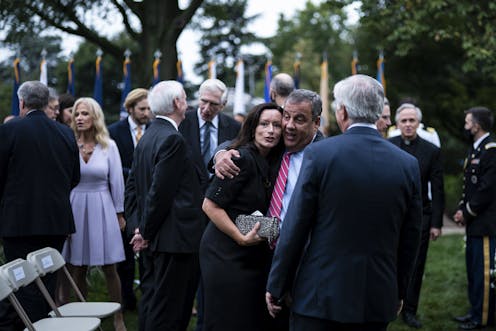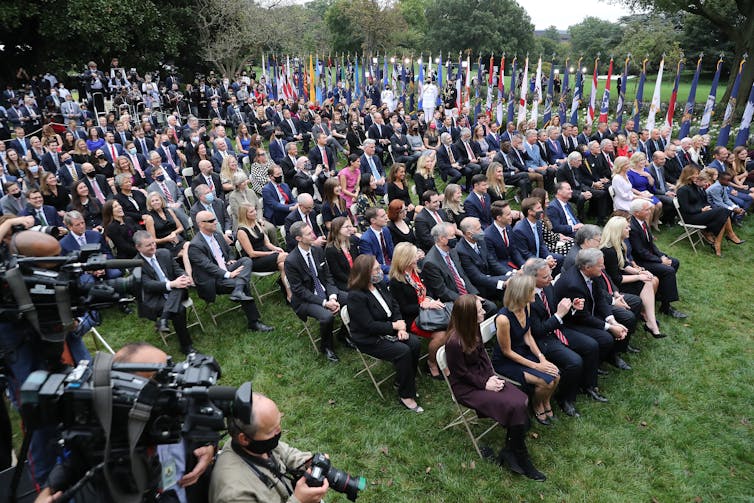Being outdoors doesn’t mean you're safe from COVID-19 – a White House event showed what not to do
The wind will disperse some virus-carrying respiratory droplets, but not everything. Masks can make the difference.

If you think you’re safe from the coronavirus just because you’re outdoors, think again.
While the wind and the large volume of air make the outdoors less risky than being indoors, circumstances matter.
Someone who is infectious can cough or sneeze, or just talk and, if you happen to inhale those respiratory droplets or they plop into your eye, you can get infected. If you shake hands with an infected person and then touch your eyes, nose or mouth, you also run a chance of getting infected. You don’t have to be inhaling an infected person’s air for very long. What matters is the dose.
As an infectious disease doctor, I get a lot of questions from patients about COVID-19 risks. Here are some answers about the risks outdoors.
Doesn’t wind make outside safer than inside?
It’s true that the wind helps disperse respiratory droplets that can carry viruses.
When you’re indoors, one of the big concerns about how the coronavirus spreads is aerosols – tiny, light droplets people emit along with larger droplets when they breathe. These particles can linger in the air, and the concentration can build up in enclosed, poorly ventilated spaces. There’s less of a risk in open outdoor settings because of the sheer volume of air and available space to physically distance.
At least one study, not yet peer reviewed, found COVID-19 patients were nearly 20 times more likely to have been infected indoors than outdoors.
But that doesn’t mean you’re in a protective bubble when outdoors.
What behaviors could put you at risk outside?
To get a sense of how easy it is to put yourself at risk outdoors, look at crowd photos from the White House Rose Garden event on Sept. 26. About 200 people attended that ceremony, and at least 12 tested positive for the virus within days, including President Donald Trump and two senators.
The first problem with this scene: Very few people were wearing face masks.
With no mask, infectious people can be shedding the virus when they talk and there is nothing to stop the respiratory droplets. For people not yet infected, no mask means the virus has several ways to enter their bodies – nose and mouth as well as eyes. The lack of masks also raises the risk of getting a larger dose, and a higher viral load may mean a higher likelihood of severe disease.

People were also seated close together. And before and after the ceremony, they mingled – indoors and outdoors – shaking hands, leaning in for close conversations and hugging each other.
Remember that just breathing expels respiratory droplets, and loud, animated speech like laughing or shouting expels more. We don’t yet know how much virus is needed to trigger symptoms, but those doses add up. So, you might get a small dose from a person sitting next to you, but if that person later gives you a big hug or shakes your hand, they could give you another dose. Or you might talk to someone else who is infectious for several minutes and inhale more virus particles.
All it takes is one person in the peak infectious period – the 24 to 48 hours before and after symptoms start – to spark a superspreader event.
When do I have to wear a mask outdoors?
Face masks lower your risk of getting infected, and they also reduce the amount of virus you’re spreading if you’re infected.
If you’re running or walking, carry a mask with you. When you’re near other people, put it on.
If you’re sitting at an outdoor café, try to mask up between bites and sips, especially if your age or health or weight make you vulnerable to severe COVID-19.
The likelihood of a passing interaction from someone walking by a table is small, but it’s still possible. The safest spot when eating outdoors is a table away from high-traffic areas and upwind of everyone else.
Is six feet of social distancing enough?
Depending on where you are, maximize the distance between yourself and others. There’s nothing magic about staying six feet apart. Particles generated by sneezes can travel a lot farther than that.
Twelve or 15 feet is safer.
It’s all about minimizing risk. You can never drive that risk to zero when you’re in public.
Can I still have people over for an outside party?
Think of the coronavirus like a sexually transmitted disease – everyone claims to behave safely, but do you really know where they’ve been? It just takes one infected person. Rapid COVID-19 tests aren’t 100% accurate, either, and are presently unavailable for most people.
To keep things safe for an outdoor gathering, set up tables for each social bubble – a family, for example. Keep the tables at least 15 to 20 feet apart. Set up food on individual plates in a central location and have people or each bubble go up separately. Don’t share utensils or food or glasses. Wear masks as much as possible, and don’t forget physical distancing.
There is a lot we still don’t know about the coronavirus, including what the long-term damage is. Regardless of how old you are or how healthy, do what you can to avoid the virus until there’s a vaccine. Even if you get over the illness quickly, we don’t know what the long-term consequences will be.
[Research into coronavirus and other news from science Subscribe to The Conversation’s new science newsletter.]
Thomas A. Russo does not work for, consult, own shares in or receive funding from any company or organisation that would benefit from this article, and has disclosed no relevant affiliations beyond their academic appointment.
Read These Next
West Antarctica’s history of rapid melting foretells sudden shifts in continent’s ‘catastrophic’ geo
A picture of what West Antarctica looked like when its ice sheet melted in the past can offer insight…
How the ‘slayer rule’ might play a role in determining who will inherit wealth from Rob Reiner and h
These rules have a long history in the United States. They played a role in the notorious murders by…
The celibate, dancing Shakers were once seen as a threat to society – 250 years later, they’re part
‘The Testament of Ann Lee,’ Mona Fastvold’s 2025 film, depicts part of the long history of Shaker…






